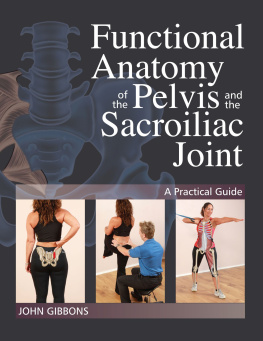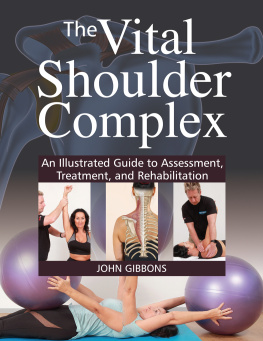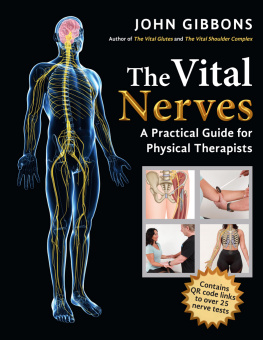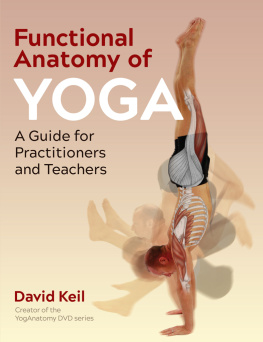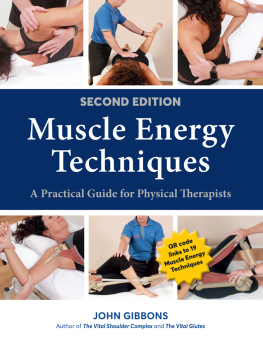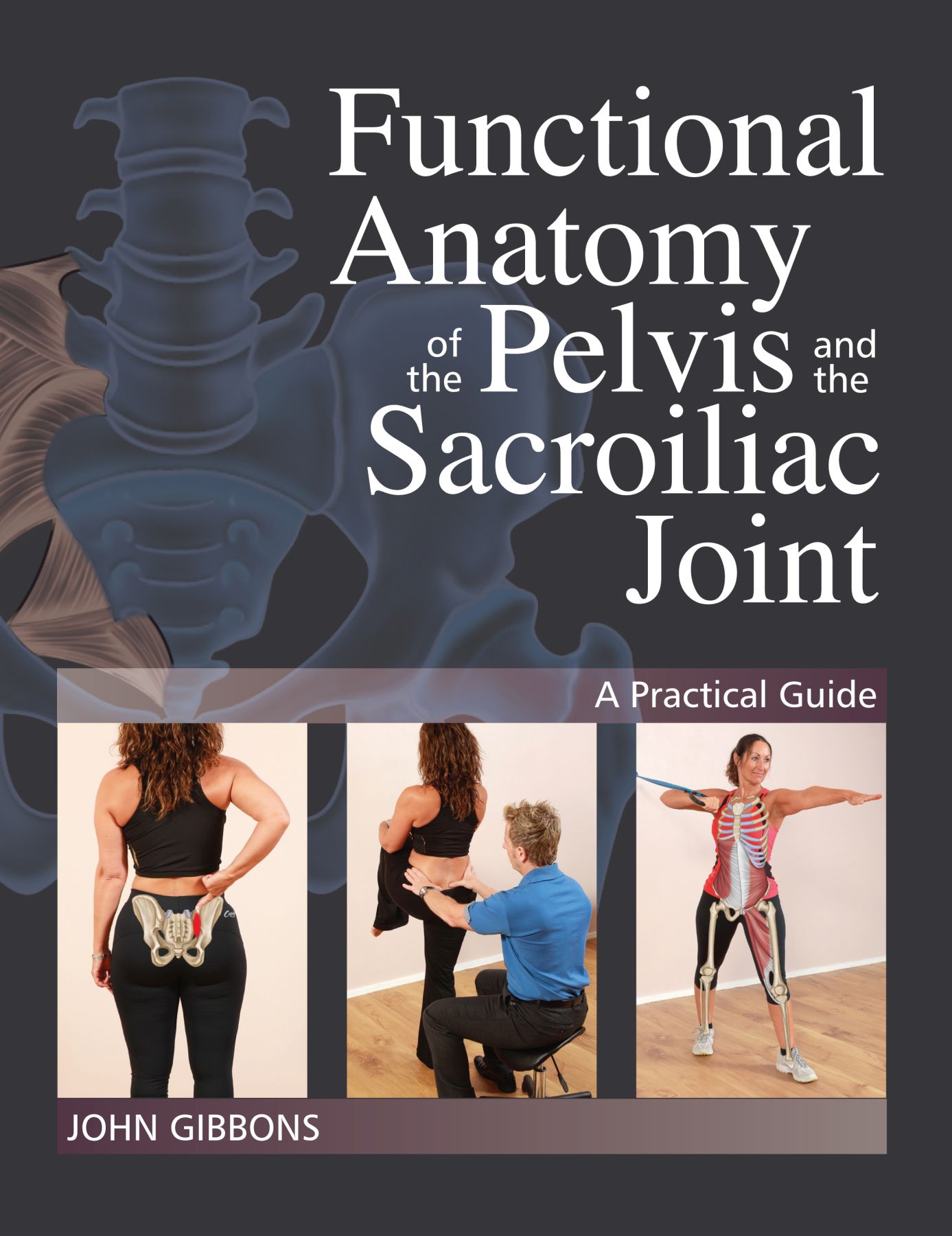Functional Anatomy of the Pelvis and the Sacroiliac Joint
A Practical Guide
John Gibbons

Chichester, England

North Atlantic Books
Berkeley, California
Copyright 2017 by John Gibbons. All rights reserved. No portion of this book, except for brief review, may be reproduced, stored in a retrieval system, or transmitted in any form or by any meanselectronic, mechanical, photocopying, recording, or otherwisewithout the written permission of the publisher. For information, contact Lotus Publishing or North Atlantic Books.
First published in 2017 by
Lotus Publishing
Apple Tree Cottage, Inlands Road, Nutbourne, Chichester, PO18 8RJ, and
North Atlantic Books
Berkeley, California
Drawings Amanda Williams
Photographs Ian Taylor
Cover Design Wendy Craig
Functional Anatomy of the Pelvis and the Sacroiliac Joint: A Practical Guide is sponsored and published by the Society for the Study of Native Arts and Sciences (dba North Atlantic Books), an educational nonprofit based in Berkeley, California, that collaborates with partners to develop cross-cultural perspectives; nurture holistic views of art, science, the humanities, and healing; and seed personal and global transformation by publishing work on the relationship of body, spirit, and nature.
North Atlantic Books publications are available through most bookstores. For further information, visit our website at www.northatlanticbooks.com or call 800-733-3000.
Medical Disclaimer
The following information is intended for general information purposes only. Individuals should always consult their health care provider before administering any suggestions made in this book. Any application of the material set forth in the following pages is at the readers discretion and is his or her sole responsibility.
British Library Cataloging-in-Publication Data
A CIP record for this book is available from the British Library
ISBN 978 1 905367 66 5 (Lotus Publishing)
ISBN 978 1 62317 102 5 (North Atlantic Books)
Library of Congress Cataloging-in-Publication Data
Names: Gibbons, John, 1968 author.
Title: Functional anatomy of the pelvis and the sacroiliac joint : a practical guide / John Gibbons.
Description: Berkeley, California : North Atlantic Books ; Nutbourne, Chichester : Lotus Publishing, 2017. | Includes . | Description based on print version record and CIP data provided by publisher; resource not viewed.
Identifiers: LCCN 2016020570 (print) | LCCN 2016019896 (ebook) | ISBN 9781623171032 (ebook) | ISBN 9781623171025 (pbk.)
Subjects: | MESH: Pelvisanatomy & histology | Sacroiliac Jointanatomy & histology | Movementphysiology
Classification: LCC QM115 (print) | LCC QM115 (ebook) | NLM WE 760 | DDC 611/.96dc23
LC record available at https://lccn.loc.gov/2016020570
I dedicate this book to my son, Thomas Rhys Gibbons, with all my love and best wishes for a happy, successful, and rewarding life.
Contents
I first realized that there were many areas of the body that still needed more attention when I was trying to consolidate the text for the last chapter of my first book, on muscle energy techniques (METs), which focused specifically on potential muscle weaknesses mainly caused by shortened and tight antagonistic muscles. In particular, I wrote about the effects (possible weakness/inhibition) of the shortened antagonistic muscles of the hip flexors on the gluteal musculature. This last chapter of the MET book inspired me so much to pursue this avenue that I decided to write an entire text on the glutes. Then, while I was writing the book on the glutes, I found that the region of the pelvic girdle and sacroiliac joint (SIJ) kept on cropping up in one way or another in most of the chapters, and so I thought it would be a marvelous idea (at the time of course!) to devote a whole book to the pelvis and SIJ.
So, after many months of contemplation and internal debate, I started writing this book in July 2014, as the initial thought of writing my fourth book had taken me a while to get my head around. Because my book on the glutes had demanded such a vast amount of my time and effort, I wasnt sure if I actually wanted to carry on writing. However, that particular week in July when Vital Glutes went to the printers was a huge stepping stone for me. I could finally focus all my attention on writing a new book, this time on what I felt was one of the most neglected areas of the bodythe pelvic girdle and in particular the SIJ.
Having taught courses on the specific areas of the pelvic girdle and lower back for many years, I have always wanted to write a book on the SIJ. The course notes each year seem to get thicker and thicker, because of the increasing amount of material. I thought to myself: now is the perfect time in my life to continue writing, and it would also make perfect sense to put pen to paper and write an entire book about this specialized and fascinating area of the body. I would love to think that, in time, this particular book will be used as a core textbook by physical therapy students and potentially serve as their main reference guide.
Another reason for writing this book was because of what I remember a good friend of mine once saying to me, while he was at university studying for a physiotherapy degree. He told me that on one occasion during the first semester, as he was being taught all the different aspects of the specific area relating to the hip joint, the tutor of the course announced that in the following semester the focus would be on the lumbar spine. My friend casually said to the tutor: What about the bit in the middle? (He was referring to the pelvis and the SIJ.) The tutor replied: That bit in the middle doesnt move, so dont worry about it!
I am pleased to say that things have moved on over the last few years, and we now know that the fascinating joints that make up the pelvic girdle do actually have some movement.
People who have come to know me over the last few years, either through attending my courses or as patients or athletes attending the clinic, will know that I am a qualified osteopath. I can honestly say with hand on heart that these individuals naturally presume that all osteopaths spend many years studying the pelvic girdle and SIJ as well as the lumbar spine, and so on. Many patients who present to the osteopathic and chiropractic clinic typically have lower back, neck, or pelvic pain. I have taught a multitude of osteopaths and chiropractors over the years, and all of them seem to have encountered different training methodologies, especially when it comes to their core knowledge base and understanding of the pelvic girdle, and this appears to reflect the specific institute of training they attended.
The reason I refer to osteopaths in particular, and the way they are perceived in terms of their knowledge, is because I want to mention something that shocked and disappointed me. I can recall a time where I was lecturing a four-day intensive course at my venue at the University of Oxford; the course in question was the Advanced Therapy Master-Class. This particular course is designed to deal specifically with the areas of the pelvis and SIJ. As well as many sports therapists and physiotherapists, there were four recently qualified osteopaths attending the course. As the course gradually progressed over the four days they all mentioned to me (individually) that the specific assessment and treatment techniques I was showing them for the area of the pelvis, SIJ, and hip, and even the lumbar spine, were new to them and that they had not been taught those specific assessment and treatment techniques during their own five-year intensive training courses. These four osteopaths were from two different training establishments; I could have understood it if they had been from a single training center, but to have all of them not being taught what I would call basic palpatory, assessment, and treatment techniques not only surprised me but actually disappointed me as well. I am pleased to say that by the end of the course those osteopaths, as well as the other therapists attending the course, had a far better understanding of how to assess and treat athletes and patients presenting with specific lower back and pelvic pain at their own clinics.

